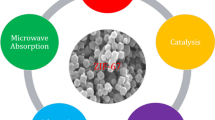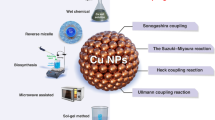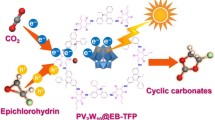Abstract
Strengthening the interaction between the substrate and the expensive transition metals such as palladium and increasing the capability of supporting in order to suppress the possibility of metal leaching from the surface is a very serious challenge in the design of a new heterogeneous catalyst. In this work, we develop the covalent functionalization of carboxylic ligand, ethylenediaminetetraacetic acid (EDTA), on the surface of the metal–organic framework of TMU-16-NH2, resulting in unparallel adsorptive ability for supporting Pd2+. The catalytic activity and stability of the synthesized catalyst named TMU-16-NH2-EDTA@Pd were studied in the Suzuki coupling reaction. We indicated that functionalization with EDTA plays a crucial role in boosting the adsorption capability of Pd and subsequently catalytic performance. The catalyst showed good reusability and has a nature truly heterogeneous due to the negligible leaching of palladium from the TMU-16-NH2-EDTA@Pd surface.











Similar content being viewed by others
Data availability
The data that support the findings of this study are available from the corresponding author upon reasonable request.
References
Lee D-H, Taher A, Hossain S, Jin M-J (2011) An efficient and general method for the Heck and Buchwald-Hartwig coupling reactions of aryl chlorides. Org Lett 13:5540–5543
Mohazzab BF, Jaleh B, Issaabadi Z, Nasrollahzadeh M, Varma RS (2019) Stainless steel mesh-GO/Pd NPs: catalytic applications of Suzuki-Miyaura and Stille coupling reactions in eco-friendly media. Green Chem 21:3319–3327
Lee KH, Han S-W, Kwon K-Y, Park JB (2013) Systematic analysis of palladium–graphene nanocomposites and their catalytic applications in Sonogashira reaction. J Colloid Interface Sci 403:127–133
Hosseini-Sarvari M, Razmi Z, Doroodmand MM (2014) Palladium supported on zinc oxide nanoparticles: synthesis, characterization, and application as heterogeneous catalyst for Mizoroki-Heck and Sonogashira reactions under ligand-free and air atmosphere conditions. Appl Catal A Gen 475:477–486
Yuan B, Pan Y, Li Y, Yin B, Jiang H (2010) A highly active heterogeneous palladium catalyst for the Suzuki-Miyaura and Ullmann coupling reactions of aryl chlorides in aqueous media. Angew Chemie Int Ed 49:4054–4058
Kashin AN, Ganina OG, Cheprakov AV, Beletskaya IP (2015) The direct non-perturbing leaching test in the phosphine-free Suzuki-Miyaura reaction catalyzed by palladium nanoparticles. ChemCatChem 7:2113–2121
Yang P, Ma R, Bian F (2016) Palladium supported on Metformin-functionalized magnetic polymer nanocomposites: a highly efficient and reusable catalyst for the Suzuki-Miyaura coupling reaction. ChemCatChem 8:3746–3754
Veisi H, Ghorbani M, Hemmati S (2019) Sonochemical in situ immobilization of Pd nanoparticles on green tea extract coated Fe3O4 nanoparticles: an efficient and magnetically recyclable nanocatalyst for synthesis of biphenyl compounds under ultrasound irradiations. Mater Sci Eng C 98:584–593
Kiani A, Alinezhad H, Ghasemi S (2023) Embedded palladium nanoparticles on metal-organic framework/covalently sulfonated magnetic SBA-15 mesoporous silica composite: as a highly proficient nanocatalyst for Suzuki-Miyaura coupling reaction in amino acid-based natural deep eutectic solvent. Appl. Organomet. Chem. 37(1):e6912
Baran T, Baran NY, Menteş A (2019) Highly active and recyclable heterogeneous palladium catalyst derived from guar gum for fabrication of biaryl compounds. Int J Biol Macromol 132:1147–1154
Sun J, Fu Y, He G, Sun X, Wang X (2015) Green Suzuki-Miyaura coupling reaction catalyzed by palladium nanoparticles supported on graphitic carbon nitride. Appl Catal B Environ 165:661–667
Puthiaraj P, Ahn W-S (2015) Highly active palladium nanoparticles immobilized on NH2-MIL-125 as efficient and recyclable catalysts for Suzuki-Miyaura cross coupling reaction. Catal Commun 65:91–95
Hemmati S, Mehrazin L, Pirhayati M, Veisi H (2019) Immobilization of palladium nanoparticles on Metformin-functionalized graphene oxide as a heterogeneous and recyclable nanocatalyst for Suzuki coupling reactions and reduction of 4-nitrophenol. Polyhedron 158:414–422
Khazaei A, Khazaei M, Nasrollahzadeh M (2017) Nano-Fe3O4@ SiO2 supported Pd (0) as a magnetically recoverable nanocatalyst for Suzuki coupling reaction in the presence of waste eggshell as low-cost natural base. Tetrahedron 73:5624–5633
Mondal P, Bhanja P, Khatun R, Bhaumik A, Das D, Islam SM (2017) Palladium nanoparticles embedded on mesoporous TiO2 material (Pd@MTiO2) as an efficient heterogeneous catalyst for Suzuki-Coupling reactions in water medium. J Colloid Interface Sci 508:378–386
Baran T (2017) Practical, economical, and eco-friendly starch-supported palladium catalyst for Suzuki coupling reactions. J Colloid Interface Sci 496:446–455
Sanaei M, Fazaeli R, Aliyan H (2019) Pd/MOF-199: as an efficient heterogeneous catalyst for the Suzukie Miyaura cross-coupling reaction. J Chinese Chem Soc 66:1290–1295
Zhang H, Liu G, Shi L, Ye J (2018) Single-atom catalysts: emerging multifunctional materials in heterogeneous catalysis. Adv Energy Mater 8:1701343
Hoskins BF, Robson R (1989) Infinite polymeric frameworks consisting of three dimensionally linked rod-like segments. J Am Chem Soc 111:5962–5964
Zhang X, Zhu Z, Rao R, Chen J, Han X, Jiang S, Yang Y, Wang Y, Wang L (2023) Highly efficient visible-light-driven photocatalytic degradation of gaseous toluene by rutile-anatase TiO2@MIL-101 composite with two heterojunctions. J Environ Sci 134:21–33
Wang Y, Li H, Xu J, Yu J, Wang J, Jiang H, Li C, Zhang X, Liu N (2024) High-performance carbon@ metal oxide nanocomposites derived metal–organic framework-perovskite hybrid boosted microwave-induced catalytic degradation of norfloxacin: performance, degradation pathway and mechanism. Sep Purif Technol 330:125399
Jie B, Lin H, Zhai Y, Ye J, Zhang D, Xie Y, Zhang X, Yang Y (2023) Mechanism, design and application of fluorescent recognition based on metal organic frameworks in pollutant detection. Chem Eng J 454:139931
Zhang X, Ma S, Gao B, Bi F, Liu Q, Zhao Q, Xu J, Lu G, Yang Y, Wu M (2023) Effect of benzoic acid and dopamine hydrochloride as a modulator in the water resistance of Universitetet i Oslo-67: adsorption performance and mechanism. J Colloid Interface Sci 651:424–435
Illes B, Hirschle P, Barnert S, Cauda V, Wuttke S, Engelke H (2017) Exosome-coated metal–organic framework nanoparticles: an efficient drug delivery platform. Chem Mater 29:8042–8046
Norouzbahari S, Lighvan ZM, Ghadimi A, Sadatnia B (2023) ZIF-8@ Zn-MOF-74 core–shell metal–organic framework (MOF) with open metal sites: synthesis, characterization, and gas adsorption performance. Fuel 339:127463
Huang C, Zhang Y, Li X, Cao H, Guo Y, Zhang C (2022) Mn-incorporated Co3O4 bifunctional electrocatalysts for zinc-air battery application: an experimental and DFT study. Appl Catal B Environ 319:121909
Bi F, Ma S, Gao B, Liu B, Huang Y, Qiao R, Zhang X (2024) Boosting toluene deep oxidation by tuning metal-support interaction in MOF-derived Pd@ZrO2 catalysts: the role of interfacial interaction between Pd and ZrO2. Fuel 357:129833
Liu N, Tang K, Wang D, Fei F, Cui H, Li F, Lei J, Crawshaw D, Zhang X, Tang L (2024) Enhanced photocatalytic CO2 reduction by integrating an iron based metal-organic framework and a photosensitizer. Sep Purif Technol 332:125873
Yang Y, Jie B, Ye J, Gan F, Yu S, Lin H, Zhang X (2023) N-doped catalysts built by iron-based metal–organic framework efficiently activated peroxymonosulfate for the tetracycline degradation. J Mol Liq 392:123505
Liu Z-Q, Chen K, Zhao Y, Kang Y-S, Liu X-H, Lu Q-Y, Azam M, Al-Resayes SI, Sun W-Y (2018) Structural diversity and sensing properties of metal–organic frameworks with multicarboxylate and 1 H-imidazol-4-yl-containing ligands. Cryst Growth Des 18:1136–1146
Furukawa H, Cordova KE, O’Keeffe M, Yaghi OM (2013) The chemistry and applications of metal-organic frameworks. Science (80-.) 341(6149):1230444
Lu W, Wei Z, Gu Z-Y, Liu T-F, Park J, Park J, Tian J, Zhang M, Zhang Q, Gentle T III et al (2014) Tuning the structure and function of metal–organic frameworks via linker design. Chem Soc Rev 43:5561–5593
Farrusseng D, Aguado S, Pinel C (2009) Metal–organic frameworks: opportunities for catalysis. Angew Chemie Int Ed 48:7502–7513
Chołuj A, Nikishkin NI, Chmielewski M (2017) Facile post-synthetic deamination of MOFs and the synthesis of the missing parent compound of the MIL-101 family. Chem Commun 53:10196–10199
Kiani A, Alinezhad H, Ghasemi S (2022) Pd nanoparticles catalyst supported on TMU-16-NH2 metal-organic framework for Sonogashira cross-coupling reaction. J Organomet Chem 958:122158
Bi F, Zhao Z, Yang Y, Gao W, Liu N, Huang Y, Zhang X (2022) Chlorine-coordinated Pd single atom enhanced the chlorine resistance for volatile organic compound degradation: mechanism study. Environ Sci Technol 56:17321–17330
Luan Y, Zheng N, Qi Y, Yu J, Wang G (2014) Development of a SO3H-functionalized UiO-66 metal-organic framework by postsynthetic modification and studies of its catalytic activities. Eur J Inorg Chem 2014:4268–4272
Saikia M, Saikia L (2016) Palladium nanoparticles immobilized on an amine-functionalized MIL-101 (Cr) as a highly active catalyst for oxidative amination of aldehydes. RSC Adv 6:14937–14947
Saikia M, Kaichev V, Saikia L (2016) Gold nanoparticles supported on nanoscale amine-functionalized MIL-101 (Cr) as a highly active catalyst for epoxidation of styrene. RSC Adv 6:106856–106865
Tanhaei M, Mahjoub AR, Safarifard V (2019) Energy-efficient sonochemical approach for the preparation of nanohybrid composites from graphene oxide and metal-organic framework. Inorg Chem Commun 102:185–191
Saedi Z, Safarifard V, Morsali A (2016) Dative and covalent-dative postsynthetic modification of a two-fold interpenetration pillared-layer MOF for heterogeneous catalysis: a comparison of catalytic activities and reusability. Microporous Mesoporous Mater 229:51–58
Kiani A, Alinezhad H, Ghasemi S (2023) Preparation immobilized Cu nanoparticles on modified metal-organic framework via linker design as an effective and highly efficient nanocatalyst for the synthesis of propargyl amines derivatives. Polycycl Aromat Compd 43:2920–2937
Nikseresht A, Shokri N, Mohammadi M, Afzalinia A, Nosratollahi S, Rostamizadeh S (2023) TMU-16-NH2: a metal--organic framework as an efficient, green, and heterogeneous catalyst for the michael addition annulations for the synthesis of a new series of 2, 4-diphenylpyrido [4, 3-d] pyrimidines Polycycl Aromat Compd 1–16
Masoomi MY, Stylianou KC, Morsali A, Retailleau P, Maspoch D (2014) Selective CO2 capture in metal–organic frameworks with azine-functionalized pores generated by mechanosynthesis. Cryst Growth Des 14:2092–2096
Bi F, Zhang X, Chen J, Yang Y, Wang Y (2020) Excellent catalytic activity and water resistance of UiO-66-supported highly dispersed Pd nanoparticles for toluene catalytic oxidation. Appl Catal B Environ 269:118767
Safarifard V, Morsali A (2014) Influence of an amine group on the highly efficient reversible adsorption of iodine in two novel isoreticular interpenetrated pillared-layer microporous metal–organic frameworks. CrystEngComm 16:8660–8663
Molander GA, Ellis N (2007) Organotrifluoroborates: protected boronic acids that expand the versatility of the Suzuki coupling reaction. Acc Chem Res 40:275–286
Dong D, Li Z, Liu D, Yu N, Zhao H, Chen H, Liu J, Liu D (2018) Postsynthetic modification of single Pd sites into uncoordinated polypyridine groups of a MOF as the highly efficient catalyst for Heck and Suzuki reactions. New J Chem 42:9317–9323
Das T, Uyama H, Nandi M (2018) Pronounced effect of pore dimension of silica support on Pd-catalyzed Suzuki coupling reaction under ambient conditions. New J Chem 42:6416–6426
Yin L, Liebscher J (2007) Carbon- carbon coupling reactions catalyzed by heterogeneous palladium catalysts. Chem Rev 107:133–173
Makhubela BCE, Jardine A, Smith GS (2011) Pd nanosized particles supported on chitosan and 6-deoxy-6-amino chitosan as recyclable catalysts for Suzuki-Miyaura and Heck cross-coupling reactions. Appl Catal A Gen 393:231–241
Acknowledgements
We would like to thank the University of Mazandaran for financial support (Research Council Grant).
Author information
Authors and Affiliations
Contributions
HA supported the expenses including the preparation of materials and analysis in the article. HA, and AK conceived the presented idea and contributed to the data curation, methodology, and validation. AA carried out the experiment. All authors reviewed the results and approved the final version of the manuscript.
Corresponding author
Ethics declarations
Conflict of interest
The authors have no conflicts of interest to declare.
Ethical approval
Not applicable.
Additional information
Handling Editor: Annela M. Seddon.
Publisher's Note
Springer Nature remains neutral with regard to jurisdictional claims in published maps and institutional affiliations.
Rights and permissions
Springer Nature or its licensor (e.g. a society or other partner) holds exclusive rights to this article under a publishing agreement with the author(s) or other rightsholder(s); author self-archiving of the accepted manuscript version of this article is solely governed by the terms of such publishing agreement and applicable law.
About this article
Cite this article
Gharanjik, A.A., Alinezhad, H. & Kiani, A. EDTA-functionalized metal–organic framework of TMU-16-NH2 decorated with Pd nanoparticles as an efficient and effective nanocatalyst in the Suzuki – Miyaura coupling reaction. J Mater Sci 59, 8169–8185 (2024). https://doi.org/10.1007/s10853-024-09681-7
Received:
Accepted:
Published:
Issue Date:
DOI: https://doi.org/10.1007/s10853-024-09681-7




